|
|

|
Porsche, and the Porsche crest are registered trademarks of Dr. Ing. h.c. F. Porsche AG.
This site is not affiliated with Porsche in any way. Its only purpose is to provide an online forum for car enthusiasts. All other trademarks are property of their respective owners. |
|
|
  |
| jk76.914 |
 Jul 15 2007, 06:24 PM Jul 15 2007, 06:24 PM
Post
#1
|
|
Senior Member    Group: Members Posts: 809 Joined: 12-April 05 From: Massachusetts Member No.: 3,925 Region Association: North East States |
Well, I have this hydraulic cam in my engine. And last fall I committed to making it work, and so now I have an update.
I'm hoping I won't get called a moron again! But here I go! This will probably be done in 3 parts- lifters, pushrods, and rockers. So I got convinced that the real issue with hydros is lack of adequate lube to the rocker boxes. I found a website that was discussing major problems with Lycoming (4 cylinder, air-cooled aircraft engines) when they transitioned to hydraulics in the late 70's. That was about the same time VW and Continental (aircraft) transitioned. VW had very similar problems, but Continental was virtually trouble-free. Many (all?) of the Lycoming problems can be explained by their implementation of hydros as opposed to the well known fact in 914 circles that hydos are, in fact, evil. In the article, it is observed that the hydraulic lifter has two roles- 1.) to adjust to changes in engine tolerances due to wear and temperature and keep the valves at zero lash, and 2.) to convey oil up the pushrods so as to lube the rockers. Inadequate oiling means inadequate cooling, stuck valves (due to oil coking on the stems), broken valves, bent pushrods, galled lifters and cams, etc, etc, etc... sound familiar? sound evil? How about valves failing (shattering) in flight? In the article, the authors go on to "point out a major shortcoming of the Lycoming design that we believe substantially accounts for valve train problems including stuck exhaust valves, prematurely worn valves and guides, and camshaft distress and failure." The early implementation in Lycoming (and VW?) focused on the first role and missed the second. I'm open to correction, but I think this was the VERY first use of hydraulic valve actuators by VW. Anyway, here's the article: http://www.prime-mover.org/Engines/Marvel/tbo3.html Every time I read it I get something more out of it.... It also touches on sodium filled valves... On my own engine, I noticed that when I adjusted the hydros to +.006" (clearance) and then idled it, there was significant oil flowing out and all over my driveway. (This in spite of the fact that I installed a half valve cover to catch oil.) When I then adjusted to -.006", the flow virtually stopped- the pushrod seated in the rocker like a valve in its seat. I re-read the article, and then started at the lifter. I bought three brands of T4 lifter- Meyle, Febi, and Isky. I disassembled them and looked at the various schemes of metering oil to the head. 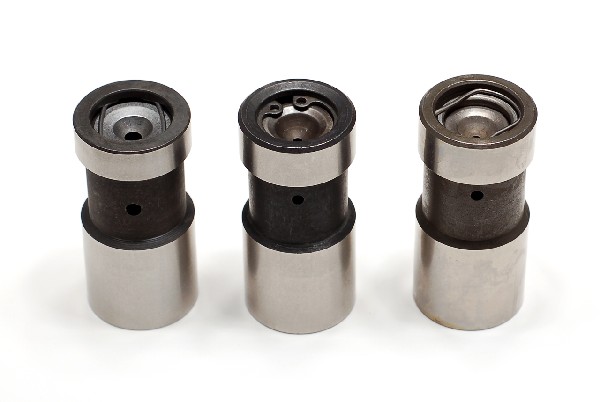 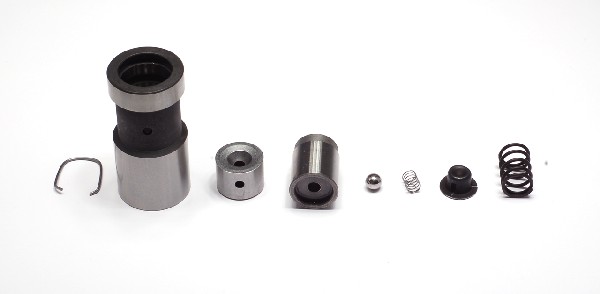 Meyle Meyle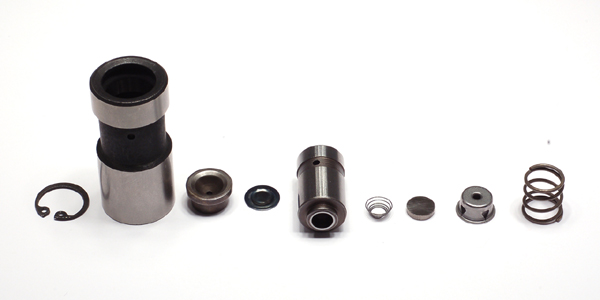 Febi (may be the same as Sealed Power) Febi (may be the same as Sealed Power)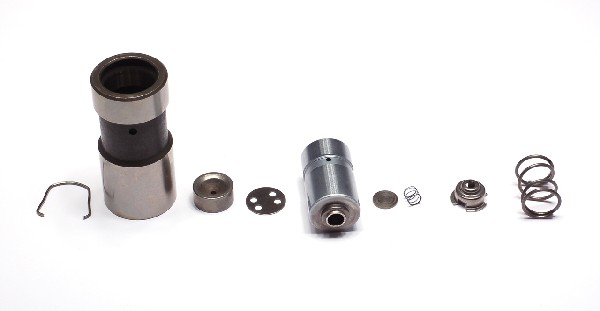 Isky (may be made by Delphi?) Isky (may be made by Delphi?)Both the Febi and the Isky have a metering disk beneath the pushrod seat that meters oil from the plunger to the pushrod. The Meyle relies on oil leakage around the pushrod seat and then into the side hole and then through the pushrod seat to the pushrod. This does not seem to me to be a reliable way to forward oil up the pushrod. Also, there is a reference to two designs of VW hydraulic lifter at this article- http://www.ratwell.com/technical/HydraulicLifters.html . In the article, Richard Atwell speculates that VW improved the design because it changed from having a paper clip style retainer to having a circlip retainer to hold it all together. Well, Meyle (questionable oiling) has a paper clip style retainer, and Febi (improved oiling) has the circlip. My theory is that VW migrated from Meyle to Febi, because the Meyle was causing failures due to inadequate lube. It's all anecdotal and speculative, but for the life of me I can't imagine how the Meyle can reliably and predictably convey oil to the head..... (beating the same dead horse) 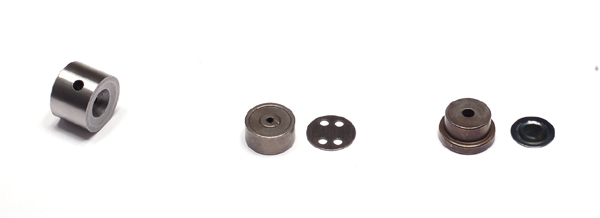 Meyle, Isky, Febi oil metering to pushrod. Meyle, Isky, Febi oil metering to pushrod.In addition to the article on Lycoming and Continental, I looked closely at Corvair (freakin' Chevy to some). 1.7 million Corvairs were built over a 10 year period, and all had hydraulic lifters. And they were never considered a reliability issue. The Corvair is basically a six cylinder Type 4 (though Corvair predates T4 by almost 10 years). So I also purchased 2 Corvair lifters- one used original Chevy and one new Sealed Power. Upon disassembly, I found oiling similar to the Isky and the Febi- both have a method of metering the oil, as opposed to relying on leakage. When GM discontinued the original Corvair part number, there was quite a bit of activity on the internet about substitutes and how effective they are in transferring oil to the rockers, so clearly it's a more openly understood requirement with the Corvair-meisters than with us T4 guys whose starting point is solid lifters...... (one of these days I'll get around to taking photos of the Corvair lifters) So anyway, after I was satisfied with which lifter I would use (I stuck with my Iskys, thought I wouldn't hesitate to use Febi either), I moved on to the pushrods.... and I'll get into that in my next post, probably in a few days.... |
| Dave_Darling |
 Jul 15 2007, 07:59 PM Jul 15 2007, 07:59 PM
Post
#2
|
|
914 Idiot           Group: Members Posts: 14,990 Joined: 9-January 03 From: Silicon Valley / Kailua-Kona Member No.: 121 Region Association: Northern California 
|
Interesting... IIRC, lack of rocker (and associated parts) oiling is not the only flaw that the hydros are supposed to have, but it sounds like you are certainly addressing things as you can!
Very cool; I look forward to seeing more results on this! Have you given any thought to external oiling for the rockers? A separate spray bar with an oil line run to it from one of the galleries? I know people have at least thought about that for the non-self-oiling "ratio rockers" that are out there. --DD |
| McMark |
 Jul 15 2007, 08:08 PM Jul 15 2007, 08:08 PM
Post
#3
|
|
914 Freak!                Group: Retired Admin Posts: 20,179 Joined: 13-March 03 From: Grand Rapids, MI Member No.: 419 Region Association: None |
Thanks! Looking forward to the rest of the 'series'. (IMG:style_emoticons/default/thumb3d.gif)
|
| 914Sixer |
 Jul 15 2007, 08:56 PM Jul 15 2007, 08:56 PM
Post
#4
|
|
914 Guru      Group: Members Posts: 8,886 Joined: 17-January 05 From: San Angelo Texas Member No.: 3,457 Region Association: Southwest Region 
|
Very interesting article. I just pulled apart a 1.7 that had an Isky hydro cam and lifters in it. The car had set for years but the cam and lifters are like new. I had the machine shop polish it and they said it was good to go. The lifters were also Isky. The sad part was the motor was running stock push rods. No wonder it did not run right! When you go to the Isky web site they show chrome-moly pushrods are required for this cam. It is an Isky 228 Hydraulic cam.
Does any one have any experiece with this cam? |
| sww914 |
 Jul 15 2007, 09:43 PM Jul 15 2007, 09:43 PM
Post
#5
|
|
Advanced Member     Group: Members Posts: 2,439 Joined: 4-June 06 Member No.: 6,146 Region Association: None |
Very interesting post. Thanks for doing all the research and sharing your information.
|
| jk76.914 |
 Jul 16 2007, 05:09 AM Jul 16 2007, 05:09 AM
Post
#6
|
|
Senior Member    Group: Members Posts: 809 Joined: 12-April 05 From: Massachusetts Member No.: 3,925 Region Association: North East States |
Very interesting article. I just pulled apart a 1.7 that had an Isky hydro cam and lifters in it. The car had set for years but the cam and lifters are like new. I had the machine shop polish it and they said it was good to go. The lifters were also Isky. The sad part was the motor was running stock push rods. No wonder it did not run right! When you go to the Isky web site they show chrome-moly pushrods are required for this cam. It is an Isky 228 Hydraulic cam. Does any one have any experiece with this cam? Mine is an Isky 229-hyd. According to their catalog, the 228 is a solid lifter cam. You might want to call them to be sure. It's possible they made a 228-hyd sometime in the past, and it's just not in the catalog. As far as pushrods go- the Isky hydraulic pushrods were way too short in my engine. I'll have photos in my next installment, and get into what I did about it. I have no issues with my Isky hydraulic cam. These guys have been grinding hydraulic-profile cams for over 50 years. The idle vacuum is a bit low, but I'm testing a work-around to that as well. I'm running pretty much stock Djet, except with Mercedes spec injectors. Jim |
| Jake Raby |
 Jul 16 2007, 06:02 AM Jul 16 2007, 06:02 AM
Post
#7
|
|
Engine Surgeon      Group: Members Posts: 9,394 Joined: 31-August 03 From: Lost Member No.: 1,095 Region Association: South East States |
A large portuion of the problem with Hydro equipped TIV engines lies in the fact that the cam never loses contact with the lifters, this makes for much more extreme wear, even on the heel of the cam lobe.
The issues with the Lycomings is a bit different than the issues we have had/seen in the past with hydros in the TIV, yes they can be the cause of failure with some valve related incidents, but most of the main reasons why I discourage them so much is wear that is related to the camshaft. With a "windowed" valve cover one can see that at most any RPM over 3,500 the entire rocker box is filled with ouil on a TIV engine with an adequate oil pump, the only thing that really ever causes a valve failure with a hydro TIV is lack of maintenance and neglect that the hydros promote. Installing hydro lifters to most people means instant neglect as the general consensus is that they do not need to ever be adjusted and thats just not true. The worst thing VW ever did to the TIV was give it Hydros from the factory and it wasn't the Engineers that did it, try the accounting and sales departments... Jim, D jet really doesn't like Hydros, they delay the opening events a lot and can lead to those low MPs you are experiencing, Ray Greenwood went over this in detail in some of his posts at the STF, search for them. |
| Johny Blackstain |
 Jul 16 2007, 06:26 AM Jul 16 2007, 06:26 AM
Post
#8
|
|
Walnut Elite Stratocaster player     Group: Members Posts: 3,434 Joined: 5-December 06 From: The Shenandoah River Member No.: 7,318 Region Association: MidAtlantic Region 
|
(IMG:style_emoticons/default/popcorn[1].gif) !
I am no mechanical engineer but find this fascinating. Mr. Raby has stated the main reason for the hydros- laziness. Adjusting valves in a teener tedious @ best. Jake has said many times that he's neglected his engines' valves for 90k+ miles now, so he's managed to get the end result of the hydros w/ out going hydro (IMG:style_emoticons/default/biggrin.gif) . Someone here on a previous hydro post stated that they only work well/properly when you use them regularly, not let them sit & keep the oil immaculate. Somehow a mythos has developed over the years that hydro = no adjustments & they were never designed for that. Finally, I've never heard of using Mercedes injectors on stock D-jet; what's that about? This stuff is great (IMG:style_emoticons/default/thumb3d.gif) ! (IMG:style_emoticons/default/cool_shades.gif) Edit: reducing service intervals & proceedures is my definition of lazy. This post has been edited by Johny Blackstain: Jul 16 2007, 06:34 AM |
| Jake Raby |
 Jul 16 2007, 06:44 AM Jul 16 2007, 06:44 AM
Post
#9
|
|
Engine Surgeon      Group: Members Posts: 9,394 Joined: 31-August 03 From: Lost Member No.: 1,095 Region Association: South East States |
Yes, I have purposely neglected my engines for the sake of record keeping and development. The engine in my 912E still hasn't had a valve adjusted since February of 2003, BUT I HAVE checked those valves religously and noted guide wear as well as valve clearances and have a log of these. That same engine went 23K miles on one oil change but that was never something I'd tell anyone else to do, I don't care if my personal engine blows to bits, I actually enjoy it.
Today the engine in my 912 has 127K on it, it racked that many miles up in less than 5 years and it is ready to come out for an autopsy- when I get the time. The ONLY benefit to hydros is the fact that they run quieter, if one is willing to absorb all the other negative aspects they create to gain just that one benefit that is their perrogative, but they have been thoroughly warned! Listen to my 4th Dimension radio show on the topic, two hours of real info from myself and my Canadian counterpart Mark Henry.. |
| rjames |
 Jul 16 2007, 03:21 PM Jul 16 2007, 03:21 PM
Post
#10
|
|
I'm made of metal     Group: Members Posts: 3,936 Joined: 24-July 05 From: Shoreline, WA Member No.: 4,467 Region Association: Pacific Northwest 
|
jk76.914, your timing is perfect.
I have hydros in my car, I wish I didn't, but that's the way it was when I got it. I'll be removing the valve covers for the first time soon to see exactly what kind of hydros I have in there and why they've been so noisy lately. Hopefully I won't find that the PO went with the Meyles. (IMG:style_emoticons/default/dry.gif) Thanks for exploring this topic! |
| Jake Raby |
 Jul 16 2007, 03:33 PM Jul 16 2007, 03:33 PM
Post
#11
|
|
Engine Surgeon      Group: Members Posts: 9,394 Joined: 31-August 03 From: Lost Member No.: 1,095 Region Association: South East States |
Loud hydros are usually due to oil pressure issues.. depending upon oil pressure to dictate valve actuation has those problems..
|
| jk76.914 |
 Jul 16 2007, 07:14 PM Jul 16 2007, 07:14 PM
Post
#12
|
|
Senior Member    Group: Members Posts: 809 Joined: 12-April 05 From: Massachusetts Member No.: 3,925 Region Association: North East States |
Thanks for all the replies. I wanted to get into the pushrods next. The rockers will take longer anyway.
So for the pushrods, I needed to address two issues- my kit pushrods were obviously too short, but I also needed to continue my quest for lubrication to the head. So I looked again to the Corvair. The Corvair pushrod has two holes on one end- one on the tip and an additional .020" hold on the side. Since the pushrod rotates with the lifter, and goes up and down, that side hole sprays oil around like a lawn sprinkler. In this case, there are 6 of those sprinkler heads in each rocker box, and believe me, it moves a lot of oil to the rocker box. |
| Bleyseng |
 Jul 16 2007, 07:37 PM Jul 16 2007, 07:37 PM
Post
#13
|
|
Aircooled Baby!           Group: Members Posts: 13,034 Joined: 27-December 02 From: Seattle, Washington (for now) Member No.: 24 Region Association: Pacific Northwest |
Hell, I have always thought with the head half full of oil that was enough to lube the rockers!
More??? its tough enough to get it to drain back fast enough. |
| Jake Raby |
 Jul 16 2007, 07:44 PM Jul 16 2007, 07:44 PM
Post
#14
|
|
Engine Surgeon      Group: Members Posts: 9,394 Joined: 31-August 03 From: Lost Member No.: 1,095 Region Association: South East States |
When all your oil ends up in the valve covers and the oil pickup starves all those mods will send you back to the drawing board.. Each valve cover can hold 1.3 quarts of oil, so that means that you have less than 1.5 quarts in the oil sump to be picked up and distributed to the engine, not counting the volume of the oil filter..
It doesn;'t take much G force at all to push that tiny amount of oil to the side of the case away from the pick up, turning on the oil light, dropping pressure and introducing nothing but air to the oil pump and effectively the main bearings. Do that a few times and see how loud your rod bearings yell at you. (especially #4, it always hurts first) |
| jk76.914 |
 Jul 16 2007, 08:39 PM Jul 16 2007, 08:39 PM
Post
#15
|
|
Senior Member    Group: Members Posts: 809 Joined: 12-April 05 From: Massachusetts Member No.: 3,925 Region Association: North East States |
Thanks for all the replies. I wanted to get into the pushrods next. Sorry I launched earlier by mistake- here's the whole story-
So for the pushrods, I needed to address two issues- my kit pushrods were obviously too short, but I also needed to continue my quest for lubrication to the head. So I looked again to the Corvair. The Corvair pushrod has two holes on one end- one on the tip and an additional .020" hole on the side. Since the pushrod rotates with the lifter, and goes up and down, that side hole sprays oil around like a lawn sprinkler. In the Corvair case, there are 6 of those sprinkler heads in each rocker box, and believe me, it moves a lot of oil to the rocker box. 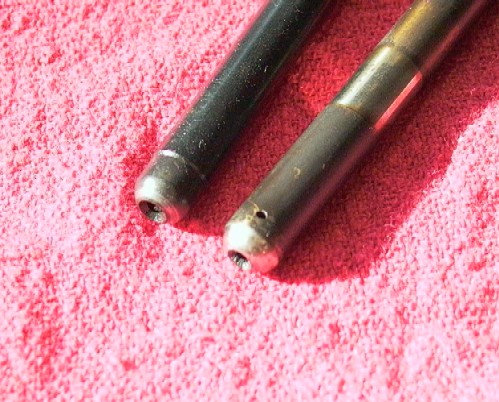 Kit pushrod and used Corvair pushrod. Kit pushrod and used Corvair pushrod.Unfortunately, the Corvair pushrod seemed too long, and besides, the hole was too near the end- it was shrouded by the cup in the rocker that the pushrod seated into. So I looked for alternatives, including laser drilling a side hole in the hardened tip of a new pushrod, but I struck out. Then I started thinking about length. With hydraulic lifters, when you adjust the screw, you are effectively changing the pushrod length. Think about it. If you screw the adjuster in, the valve doesn't open. No, the lifter plunger goes further into the lifter body and self-adjusts to that new position. In a solid lifter engine you get the same effect by shortening the pushrod. So how do I determine the "correct" pushrod length? While I thought about that, I looked at the wear pattern on the tip of the adjuster screw. The tip has a spherically ground surface. With my short pushrods, this "skid mark" was skewed towards the edge nearest the rocker shaft, and the mark was very long. So the screw was sliding across the valve tip as it opened the valve, and then retreating as it closed the valve. Thinking about the geometry, I realized that the slide of the adjuster screw across the valve tip is minimized when the axis of the screw is perpendicular to a radius from the center of the rocker shaft, which is the pivot point.... A picture is worth a thousand words- 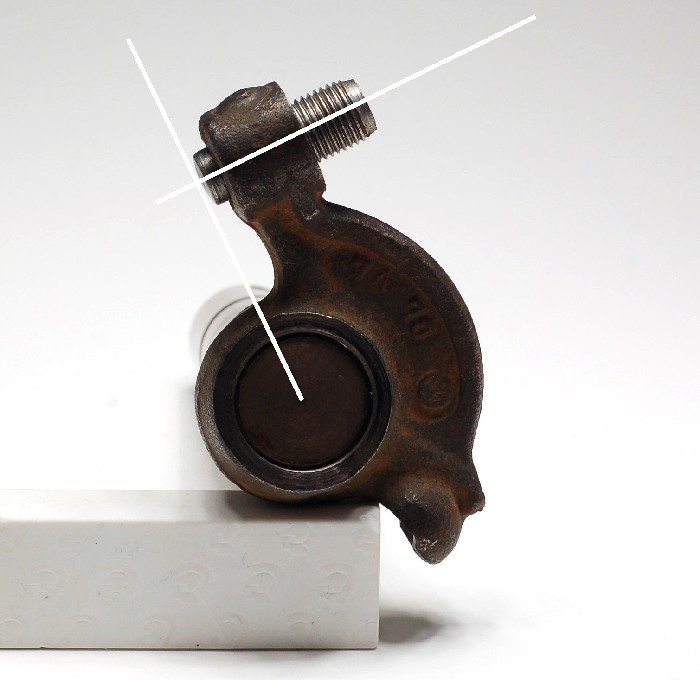 If you move the screw either in or out from this position, you move the tip further from the pivot centerline, and so its motion resulting from a fixed angular swing of the rocker increases. To determine pushrod length, I started by setting the adjuster screw to this nominal position. I also made a tool- I took two Meyle lifters and assembled them with carefully cut lengths of pushrod tubing in the bottom, also filling the cavity with Gorilla glue. The tubing was cut to provide a pushrod seat height that is -.030" below the free length of a standard lifter. This gave me a "solid lifter" that emulated a 1 turn lash from zero- .030" x 1.3 (rocker ratio) = .040", which is extremely close to 1mm at the valve, which is 1 turn (10mm x 1 thread pitch). 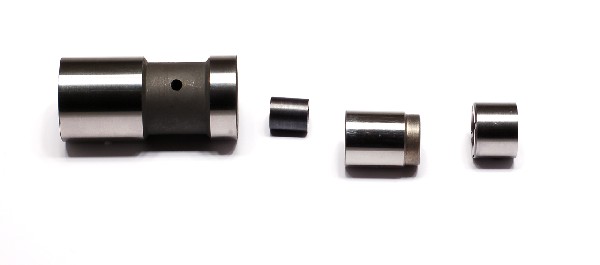 Now I could put the modified lifters into the lifter bore, assemble with a test pushrod, turn the engine over 2 turns, and observe the valve geometry. Keep trying different length pushrods until it looked right at half lift, and I'm done. The only trouble was, I was doing this with the engine in the car, and even though I managed to rig my dial indicator to find half lift, visualizing the screw axis being perpendicular to the valve stem was tough. I tried photographing it and then enlarging the photos, which actually worked, but it wasn't easy or precise- too visual. So I tried taking advantage of the skid mark on the adjuster screw. I know that when my pushrods were too short, the mark was skewed off the edge, and that on my original screws on my original solid cam, they were nicely centered and short. So I tried coating the adjuster tip with blue dykem, carefully assembling the shaft, installing the assembled shaft onto the engine, and then turning the engine over my 2 turns. The movement of the screw across the valve stem tip left a very nice mark on the screw that I could "read" standing up in the comfort of my workshop. 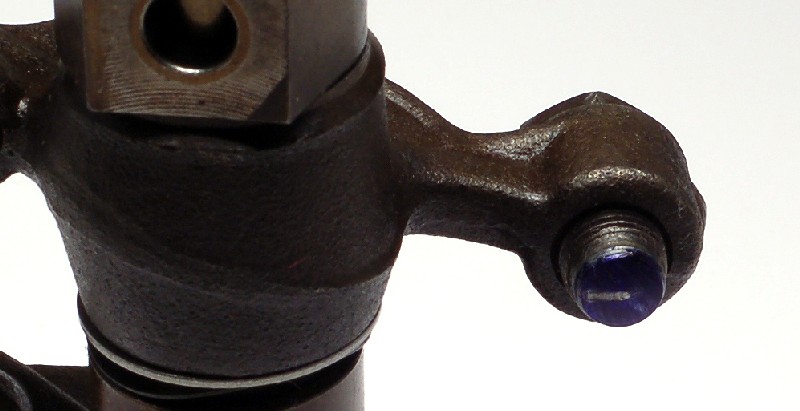 This pushrod is too short. I could have improved this by turning the screw out, but I wanted to try and get close to perfect at 1 turn. That gives me +/- 1/2 turn to tweak to perfection. So I tried a longer pushrod- 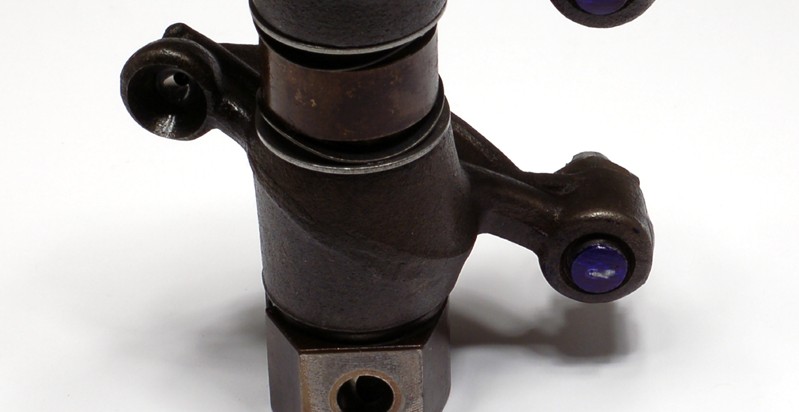 (I know this isn't the same one, but it illustrates the process. Also, this one is at the "nominal" screw position- see how short it is?) I THINK THIS WOULD BE A GREAT WAY TO CHECK VALVE GEOMETRY ON A SOLID LIFTER ENGINE! (assuming you're using 10mm stock adjusters anyway) Just lash to spec, snug up the lock nuts, remove the rockers and shaft intact, clean, blue dykem, reinstall, turn over 2 turns, remove, and look at what you have. Interestingly, to hold the adjuster screw to my "nominal" position, I had to shorten 6 of my rocker pedistals by .020". (Later I actually did the math, and learned that the amount of slide is very INSENSITIVE to the screw being off nominal. Oh well.) MORE AMAZING- when I got through it all, turns out that the CORVAIR STANDARD LENGTH PUSHROD WAS PRECISELY THE CORRECT LENGTH ON MY 914!!!! It wasn't too long after all! I have nicely centered and short skid marks on my adjuster screws. Way different from the kit rods, which were about .200" too short- 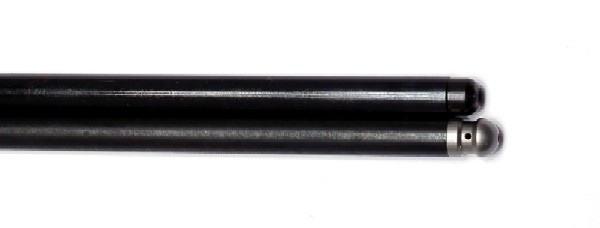 Isky kit vs. Otto Parts Corvair. Isky kit vs. Otto Parts Corvair.The Otto Parts pushrod is now sold by Clark's Corvair Parts. This one is standard Corvair 10 7/32", but they are available in about .025" increments in about 10 lengths. Actual length required is greatly a function of your cam- base circle diameter as well as lift. With my Isky 229-hyd it happens to be the stock Corvair length. The last piece of the puzzle was the oil hole. I decided to use the Corvair parts, and I solved the shrouding issue by grinding a relief in the rocker, being sure not to go near the polished part the pushrod seats into. The other big advantage of this approach- if I had found a way to redrill lower on the pushrod to clear the rocker cap, I would have buried it into the pushrod tube- even worse. 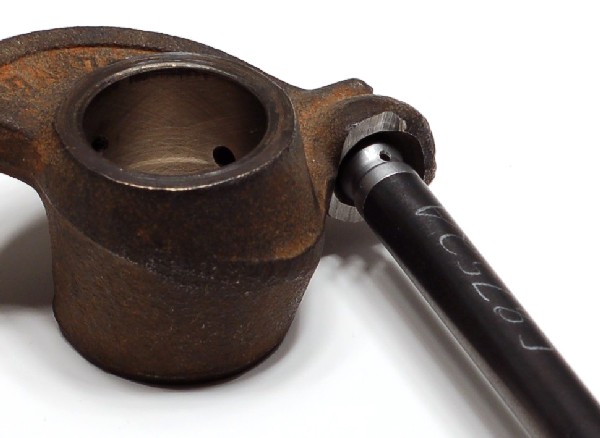 The pushrod isn't seated in the rocker in the photo, but you can see how I ground back the rocker to unshroud the oil hole. I got better as I went along! But notice that I only ground the half of the cap nearest the rocker shaft? I didn't want the oil to spray directly onto the valve cover gasket as the pushrod turns. Also, there isn't a straight shot with the VW valve scheme anyway, so I'm relying on filling the rocker boxes with an oil mist as much as spraying directly on any particular point. So that's where I ended up with pushrods. There's a eplilog to the pushrod discussion though, but it'll wait for the rocker installment. |
| jk76.914 |
 Jul 16 2007, 08:43 PM Jul 16 2007, 08:43 PM
Post
#16
|
|
Senior Member    Group: Members Posts: 809 Joined: 12-April 05 From: Massachusetts Member No.: 3,925 Region Association: North East States |
Hell, I have always thought with the head half full of oil that was enough to lube the rockers! More??? its tough enough to get it to drain back fast enough. The .020" hole is actually less than you have with solid lifters and an annulus caused by .006" lash. I was trying to RECOVER this oil flow, which I lost by going to zero lash. It's not incremental. Plus, in the next installment, you'll find out why I only ended up putting the Corvair pushrods on the two intake valves on each side. Also, keep in mind, this is a street car (hydraulic lifters, remember?), so you won't be revving it like the engines you guys build and drive. |
| Jake Raby |
 Jul 16 2007, 08:43 PM Jul 16 2007, 08:43 PM
Post
#17
|
|
Engine Surgeon      Group: Members Posts: 9,394 Joined: 31-August 03 From: Lost Member No.: 1,095 Region Association: South East States |
One thing to consider is the fact that adding those oilers to the pushrods is going to drop the operating oil pressure within the lifter and oil pressure is what makes the hydro lifter function, so proceed with caution.
|
| jk76.914 |
 Jul 16 2007, 08:43 PM Jul 16 2007, 08:43 PM
Post
#18
|
|
Senior Member    Group: Members Posts: 809 Joined: 12-April 05 From: Massachusetts Member No.: 3,925 Region Association: North East States |
When all your oil ends up in the valve covers and the oil pickup starves all those mods will send you back to the drawing board.. Each valve cover can hold 1.3 quarts of oil, so that means that you have less than 1.5 quarts in the oil sump to be picked up and distributed to the engine, not counting the volume of the oil filter.. It doesn;'t take much G force at all to push that tiny amount of oil to the side of the case away from the pick up, turning on the oil light, dropping pressure and introducing nothing but air to the oil pump and effectively the main bearings. Do that a few times and see how loud your rod bearings yell at you. (especially #4, it always hurts first) The .020" hole is actually less than you have with solid lifters and an annulus caused by .006" lash. I was trying to RECOVER this oil flow, which I lost by going to zero lash. It's not incremental. Plus, in the next installment, you'll find out why I only ended up putting the Corvair pushrods on the two intake valves on each side. Also, keep in mind, this is a street car (hydraulic lifters, remember?), so you won't be revving it like the engines you guys build and drive. |
| jk76.914 |
 Jul 16 2007, 08:55 PM Jul 16 2007, 08:55 PM
Post
#19
|
|
Senior Member    Group: Members Posts: 809 Joined: 12-April 05 From: Massachusetts Member No.: 3,925 Region Association: North East States |
One thing to consider is the fact that adding those oilers to the pushrods is going to drop the operating oil pressure within the lifter and oil pressure is what makes the hydro lifter function, so proceed with caution. That's a good point. But I don't think it'll drop below where is is for solid lifters, because that .020" hole (times 4 intake valves) is less "leakage" than 8 pushrods at .006" lash. Of course that's on paper, I know. Also, my case is a '76 GC case without out the oil pressure regulator, though that only does anything above maybe 4500 RPM, I understand. The lifters rely on oil pressure to fill them. When they rise up the ramp on the cam, the check valve closes and then the only way out is leakage around the plunger, which doesn't depend on engine oil pressure. I have noticed that I have to drive about 8 miles at 3000 RPM to get the lifters to fill from empty. Seems like too long, but I don't have other recent data points. I'd be smarter if I had a oil pressure gauge on the car so I can see what's going on. |
| Jake Raby |
 Jul 16 2007, 09:01 PM Jul 16 2007, 09:01 PM
Post
#20
|
|
Engine Surgeon      Group: Members Posts: 9,394 Joined: 31-August 03 From: Lost Member No.: 1,095 Region Association: South East States |
Solid lifters do not rely on oil pressure to function, hydros do- huge difference.
|
  |
1 User(s) are reading this topic (1 Guests and 0 Anonymous Users)
0 Members:

|
Lo-Fi Version | Time is now: 22nd May 2024 - 08:24 PM |
Invision Power Board
v9.1.4 © 2024 IPS, Inc.








